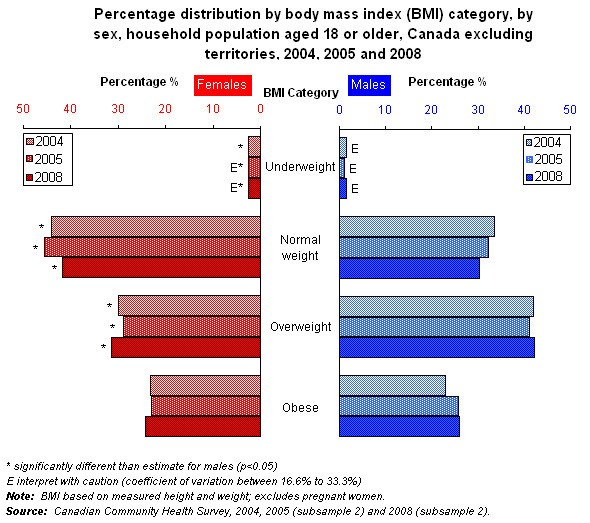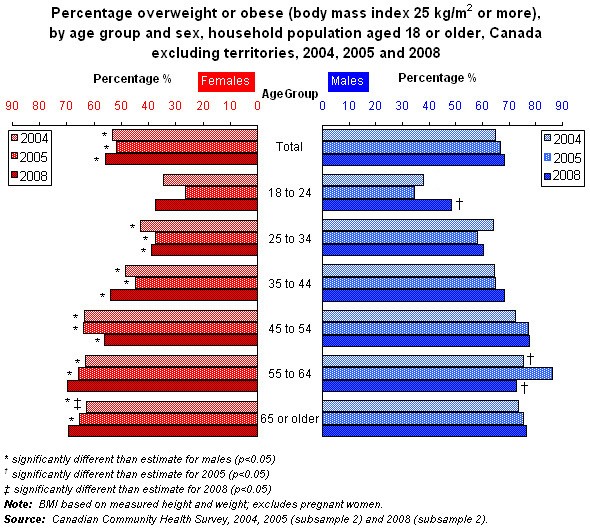Publications
Healthy people, healthy places
+Demographic change
+Health status
+Health behaviours
+Environment
Adult body mass index (BMI)
Archived Content
Information identified as archived is provided for reference, research or recordkeeping purposes. It is not subject to the Government of Canada Web Standards and has not been altered or updated since it was archived. Please "contact us" to request a format other than those available.
Body mass index (BMI) is a method of classifying body weight according to health risk. It is calculated for the population aged 18 or older, excluding pregnant women and people shorter than 3 feet (0.914 metres) or taller than 6 feet 11 inches (2.108 metres). BMI is calculated as weight in kilograms divided by height in metres squared.
This report presents BMI based on measured height and weight data, which most accurately reflect the true values. However, because of the higher cost, these data are collected less frequently than self-reported data.
BMI based on self-reported height and weight is also available in Health Indicators. These respondent-reported data tend to underestimate weight and overestimate height, both of which influence the calculation of BMI and associations with morbidity1,2. Misreporting can vary by method of data collection, for example, telephone versus personal interview.
According to World Health Organisation (WHO) and Health Canada guidelines, health risk levels are associated with each of the following BMI categories; normal weight = least health risk; underweight and overweight = increased health risk; obese class I = high health risk; obese class II = very high health risk; obese class III = extremely high health risk.
| Category | BMI | Risk to health |
| Underweight | less than 18.5 | Increased health risk |
| Normal weight | 18.5 to 24.9 | Least health risk |
| Overweight | 25.0 to 29.9 | Increased health risk |
| Obese class I | 30.0 to 34.9 | High health risk |
| Obese class II | 35.0 to 39.9 | Very high health risk |
| Obese class III | 40.0 or more | Extremely high health risk |
Canadian Guidelines for Body Weight Classification in Adults
Importance of indicator
The percentage of Canadians who are overweight or obese has been increasing in recent years3. The health consequences of excess weight include increased risk of physical chronic conditions and psychosocial problems4. Given that excess weight is a risk factor for other conditions, monitoring trends in overweight and obesity is important in order to prepare for potential changes in the health status of the population and to anticipate demands for health services.
Background
Overweight and obesity are associated with health risks. Excess weight is a risk factor for type 2 diabetes, cardiovascular disease, high blood pressure, obstructive sleep apnea, osteoarthritis, some cancers, and gallbladder disease5.
However, the degree to which a moderately elevated BMI (overweight as opposed to obese) is associated with health risk is unclear. Studies have produced conflicting results6,7,8,9.
Obese individuals have an increased risk of dying. People who are underweight are also at increased risk of death, although this is thought to be mainly because of underlying disease processes that produce weight loss9.
Highlights and graphs
BMI category by sex

- In recent years, approximately 42% of men and 30% of women aged 18 or older were estimated to be overweight, and a further 26% of men and 24% of women, obese.
- Women were more likely than men to be underweight or normal weight, while men were more likely to be classified as overweight.
- Men and women were equally likely to be obese.
Note: BMI was calculated based on measured height and weight and excludes pregnant women BMI is calculated as follows: weight in kilograms divided by height in metres squared.
Overweight or obese by age group and sex

- In recent years, more than half of Canadian women aged 18 or older were overweight or obese, compared with two-thirds of men: an estimated 7.1 million women and 8.6 million men in 2008.
- Among both sexes, overweight/obesity was less prevalent at younger ages. Nevertheless, half of men (49%) and more than a third of women (38%) aged 18 to 24 years were overweight or obese in 2008.
- Men were more likely than women to be classified as overweight or obese overall, and in every age group from age 25 and older. At ages 18 to 24, men were no more likely than women to be overweight or obese.
- From 2005 to 2008, the percentage of men aged 18 to 24 who were overweight or obese increased significantly from 35% to 49%.
- The proportion of senior women classified as overweight or obese increased from 63% in 2004 to 70% in 2008. The percentage of senior men in this category also rose over the same periods, but the change was not statistically significant.
Note: BMI calculated based on measured height and weight and excludes pregnant women BMI is calculated as follows: weight in kilograms divided by height in metres squared.
References
1. Shields, M, Connor Gorber S, Tremblay MS. Estimates of obesity based on self-report versus direct measures. Health Reports (Statistics Canada, Catalogue 82-003) 2008; 19(2): 61-76.
4. Haslam DW, James WPT. Obesity. Lancet 2005; 366: 1197-209.
5. Health Canada. Canadian Guidelines for Body Weight Classification in Adults (Catalogue H49-179) Ottawa: Health Canada, 2003.
6. Romero-Corral A, Montori VM, Somers VK, et al. Association of bodyweight with total mortality and with cardiovascular events in coronary artery disease: A systematic review of cohort studies. Lancet 2006; 368(9536): 666-78.
7. Adams KF, Schatzkin A, Harris TB, et al. Overweight, obesity and mortality in a large prospective cohort of persons 50 to 71 years olds. New England Journal of Medicine 2006; 355(8): 763-78.
8. Jee SH, Sull JW, Park J et al. Body-mass index and mortality in Korean men and women. New England Journal of Medicine 2006; 355(8): 779-87.
9. Flegal KM, Graubard BI, Williamson DF et al. Excess deaths associated with underweight, overweight, and obesity. JAMA. 2005;293(15):1861-1867.
Other studies
Che J. Underweight Canadians. Canadian Social Trends (Statistics Canada , Catalogue 11-008) 2002; 67: 6-11.
Connor Gorber S, Shields M, Tremblay MS, McDowell I. The feasibility of establishing correction factors to adjust self-reported estimates of obesity. Health Reports (Statistics Canada, Catalogue 82-003) 2008; 19(3): 71-82.
Connor Gorber S, Tremblay M, Moher D, Gorber B. A comparison of direct versus self-report measures for assessing height, weight and body mass index: a systematic review. Obesity Reviews 2007; 8(4): 373-374.
Deering KN, Lix L, Bruce S, Young TK. Chronic disease and risk factors in Canada's northern populations: longitudinal and geographic comparisons. Canadian Journal of Public Health 2009; 100(1):14-17.
Garriguet D. Obesity and the eating habits of the Aboriginal population. Health Reports (Statistics Canada, Catalogue 82-003) 2008; 19(1): 21-35.
Gilmore J. Body mass index and health. Health Reports (Statistics Canada, Catalogue 82-003) 1999; 11(1): 31-43.
Gilmour H. Physically active Canadians. Health Reports (Statistics Canada, Catalogue 82-003) 2007; 18(3): 45-65.
Le Petit C, Berthelot J-M. Obesity—a growing issue. Health Reports (Statistics Canada, Catalogue 82-003) 2006; 17(3): 43-50.
Orpana HM, Tremblay MS, Finès P. Trends in weight change among Canadian adults. Health Reports (Statistics Canada, Catalogue 82-003) 2007; 18(2): 9-16.
Ross NA, Tremblay S, Khan S, Crouse D, Tremblay M, and Berthelot J-M. Body mass index in urban Canada : Neighbourhood and metropolitan area effects. American Journal of Public Health 2007 Mar; 97(3):500-8.
Shields M, Tremblay MS. Screen time among Canadian adults: A profile. Health Reports (Statistics Canada, Catalogue 82-003) 2008; 19(2): 31-43.
Shields M, Connor Gorber S, Tremblay MS. Estimates of obesity based on self-report versus direct measures. Health Reports (Statistics Canada, Catalogue 82-003) 2008; 19(2): 61-76.
Shields M, Connor Gorber S, Tremblay MS. Associations between obesity and morbidity: effects of measurement methods. Obesity Reviews 2008 Sep; 9(5):501-2.
Shields M. Overweight and obesity among children and youth. Health Reports (Statistics Canada, Catalogue 82-003) 2006; 17(3): 27-42.
Shields M, Tjepkema M. Regional differences in obesity. Health Reports (Statistics Canada, Catalogue 82-003) 2006; 17(3): 61-7.
Shields M, Tjepkema M. Trends in adult obesity. Health Reports (Statistics Canada, Catalogue 82-003) 2006; 17(3): 53-9.
Tremblay MS, Pérez CE, Ardern CI, et al. Obesity, overweight and ethnicity. Health Reports (Statistics Canada, Catalogue 82-003) 2005; 16(4): 23-34.
Wilkins K, de Groh M. Body mass and dependency. Health Reports (Statistics Canada, Catalogue 82-003) 2005; 17(1): 27-39.
- Date modified:
